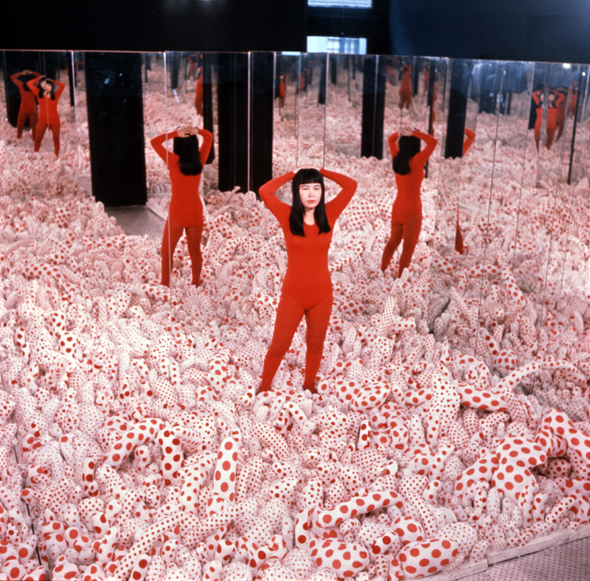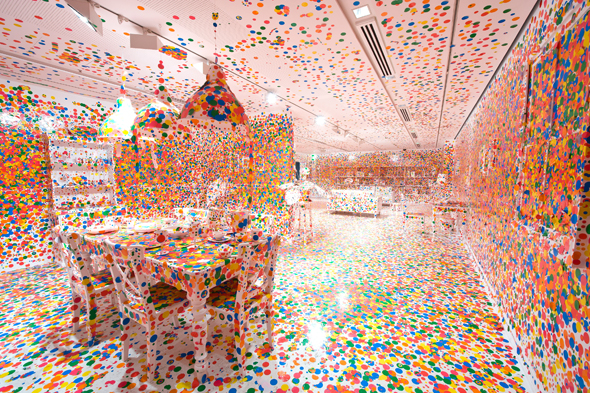
Known for her dazzling walk-in installations and avant-garde artwork, Japanese artist Yayoi Kusama will offer an unprecedented glimpse inside her dizzying world with a North American tour that commences at the Hirshhorn Museum and Sculpture Garden in Washington DC. From Feb 23, 2017 to May 14, 2017 the museum will host an in-depth retrospective of her works, entitled “Yayoi Kusama: Infinity Mirrors.” Spanning over her fifty-year-long career, the show will display the evolution of her immersive installations, alongside paintings, works on paper and sculptures.
The artist, born in 1929 in Nagano, Japan moved to New York City in the 1950s where she slowly became a significant figure in the post-war art scene. Often considered an influence to the likes of pop-art ingénue Andy Warhol, Kusama is thought to have been a major player in the pop-art movement in America. During her New York tenure, she exhibited alongside heavyweight artists like Claes Oldenburg. Decades later, Kusama has become one of the most significant artists of our generation, with fans waiting eagerly for hours to get a view inside one of her hypnotic creations. Melissa Chiu, the director of the Hirshhorn said in a press release, “Yayoi Kusama is among the most influential artists alive today. A worldwide phenomenon, she has created a vast oeuvre that defies traditional classification, and we are honored to present the first survey of her Infinity Mirror Rooms.”
The exhibit, starting at the Hirshhorn, is Kusama’s first North American tour in nearly two decades. After Washington D.C. the show is slated to head to the Seattle Art Museum in the summer of 2017. Following Seattle, the tour will move on to several locations that have yet to be released.
Kusama rose to fame using her trademark polka dots and immersive performance art. By 1950 in Japan Kusama started to feature polka dots in paintings and then began to cover surfaces in dots—which was imagery from her very own hallucinations. One of her most iconic polka dot creations was “The Obliteration Room”, a white room featuring completely mundane objects, such as tables, chairs a couch and a teapot. As visitors entered the space, they were handed multicolored dot stickers and were told to leave their mark on the installation, which eventually transformed the room into a vibrant, dotted unrecognizable space, and possibly look inside Kusama’s convoluted mind.

“The Obliteration Room” was originally presented at the Queensland Art Gallery’s fourth Asia Pacific Triennial of Contemporary Art. It has since been staged at several other locations worldwide, including David Zwirner Gallery in New York and the Tate in London, and will be presented yet again at The Hirshhorn.
The works will be organized chronologically starting with “Infinty Mirror Room-Phalli’s Field,” a combination of eroticism
and surreal pop-art that she created in 1965, featuring mirrored walls with hundreds of polka dot fabric phallic shaped tropes. It will also include “Love Forever,” a hexagonal room where viewers look in from the outside and see flashing lights that reflect throughout the room. Other works displayed at the exhibit include “Dots Obsession—Love Transformed into Dots,” a domed mirror surrounded by inflatable figures, “Aftermath of Obliteration of Eternity” and the famous “Souls of Millions of Light Years Away.” The exhibit concludes with Kusama’s iconic “The Obliteration room.”
Mika Yoshitake, the museum’s associate curator in a press release said, ”The infinity rooms invite the viewer to experience a myriad of dualities, challenging preconceived notions of autonomy, time and space.”
In 2014, the Art Newspaper conducted a survey of museum attendance and crowned Kusama as its champion artist. The findings are no revelation as her exhibitions have created worldwide fanfare, drawing masses from every corner of the globe. Her 2013 work, “The Soul of Millions of Light Years Away,” also presented in the survey at the Hirschhorn, originally opened at New York’s David Zwirner Gallery. Every day, thousands of visitors arrived to experience a glimpse into Kusama’s ethereal world—an immersive room hung with 75 colored LED bulbs that flickered in cosmic bliss, featuring a festival of lights in darkness.
Kusama moved back to her native Japan in the ‘70s from New York, where she now creates pieces from her Tokyo studio. In 1975, Kusama checked herself into the Seiwa Hospital for the mentally ill and has lived there full time since 1977, by choice. Her studio is only a five-minute walk from the hospital, which allows her to fully focus on her work. The eccentricity and dreamlike quality of her creations and the drug-like incarnations of the images portrayed are in relation to her own visions, which stemmed from nervous disorders and hallucinations she’s had since childhood. The images have included dots, forms of phallic objects and worm like shapes. Kusama has said she doesn’t want to cure her mental illness, rather use it as a force to create powerful artwork, which speaks volumes for her half-a-century-long career. Her work transcends individuals into the immersive artwork itself. An experience, rather than just a view inside, creating an illusory, ethereal sensory journey through the cosmos.
Text by Lena Vazifdar

